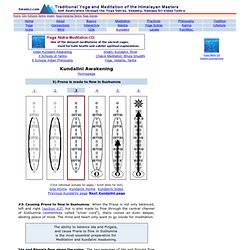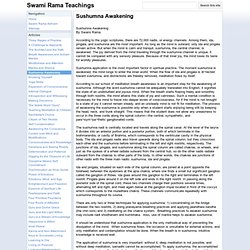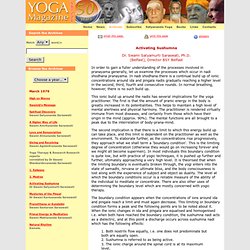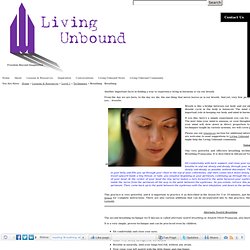

Kundalini Awakening - Prana flows in Sushumna. #3: Causing Prana to flow in Sushumna: When the Prana is not only balanced, left and right (section #2), but is also made to flow through the central channel of Sushumna (sometimes called "silver cord"), there comes an even deeper, abiding peace of mind.

The mind and heart only want to go inside for meditation. Ida and Pingala flow along the spine: The two energies of Ida and Pingala flow along the spine (meru danda) of the subtle body. Ida flows along the left side, and Pingala flows along the right. Sushumna nadi flows directly upwards and downwards, between Ida and Pingala, coursing through the chakras. Ida and Pingala join at the ganglion of ribes: Within the many ganglionated cords of the nervous system, there is a nerve center in the area of the ajna chakra, at the space between the eyebrows, that is called the ganglion of ribes.
Ida and Pingala also join at the ganglion impar: The ganglion impar is the lower termination point of the sympathetic nervous system. Universal Tao: diamond. Qigong for Meditators: Full Spinal Breathing. Sushumna Awakening - Swami Rama Teachings. Sushumna AwakeningBy Swami Rama According to the yogic scriptures, there are 72,000 nadis, or energy channels.

Among them, ida, pingala, and sushumna are the most important. As long as the mind is outward, only ida and pingala remain active. But when the mind is calm and tranquil, sushumna, the central channel, is awakened. The joy derived from the mind traveling through the sushumna channel is unique; it cannot be compared with any sensory pleasure. Sushumna application is the most important factor in spiritual practice. According to our school of meditation breath awareness is an important step for the awakening of sushumna. The sushumna nadi is centrally located and travels along the spinal canal.
Activating Sushumna. In order to gain a fuller understanding of the processes involved in pranayama generally, let us examine the processes which occur in nadi shodhana pranayama.

In nadi shodhana there is a continual build up of ionic concentrations around ida and pingala nadis gradually reaching a higher level in the second, third, fourth and consecutive rounds. In normal breathing, however, there is no such build up. This ionic build up around the nadis has several implications for the yoga practitioner. The first is that the amount of pranic energy in the body is greatly increased in its potentialities. This helps to maintain a high level of mental alertness and physical harmony. The second implication is that there is a limit to which this energy build up can take place, and this limit is dependent on the practitioner as well as the environment.
The boundary condition appears when the concentrations of ions around ida and pingala reach a limit and must again decrease. Living Unbound. Another important facet in finding a way to experience living in harmony is via our breath.

From the day we are born, to the day we die, the one thing that never leaves us is our breath. And yet, very few people actually ever breathe consciously. One way to calm the mind is to … yes… breathe. Breath is like a bridge between our body and our mind. All bodily processes run more efficiently when the oxygen/carbon dioxide cycle in the body is balanced. If you like, here’s a simple experiment you can try, to prove this connection between mind, breath and body to yourself. Please see our resources section for additional information on breathing techniques for Living Unbound. Spinal Breathing Pranayama One very powerful and effective breathing technique, which can be combined with daily meditation, is called Spinal Breathing Pranayama. Sit comfortably with back support, and close your eyes just as you do when you meditate.
Alternate Nostril Breathing Important pointers: Teachings: Resources: Consultations. AYP Lesson 206 - Varieties of Spinal Breathing. Note: For the complete lessons, with additions, see the AYP Easy Lessons for Ecstatic Living Books.

Lesson 206 - Q&A – Varieties of spinal breathing From: Yogani Date: Sat Jun 5, 2004 11:54pm New Members: It is recommended you read from the beginning of the web archive, as previous lessons are prerequisite to this one.